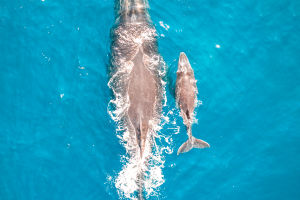It has been discovered that the ocean world is not devoid of noise, as orcas and dolphins engage in communications that can be described as "gossip".
Within the vibrant natural world, creatures rely on various means to communicate and convey information.
As the only species endowed with advanced language abilities, humans enjoy the convenience of communication.
But what about the ocean-dwelling animals, who inhabit a realm known for its abundance of sound? Do they also engage in their own form of "gossip"?
The marine world is a mysterious and remarkably diverse place, and biologists have observed that certain marine animals, including dolphins and killer whales, possess the ability to communicate.
Dolphins are widely recognized as highly intelligent marine animals. They symbolize love and peace and have even been known to rescue humans in distress at sea.
Through the study of dolphin brains, scientists have determined that they exhibit social behavior, which is particularly notable in the tranquil ocean environment. Dolphins demonstrate the ability to differentiate between objects and possess a level of self-awareness.
The magnificent Orcas are actually a part of the dolphin family. They, too, engage in social behavior and can communicate with one another, even indulging in their own version of "gossip."
This notion may seem astonishing since dolphins are typically associated with activities like swimming and hunting. However, extensive research has revealed that dolphins possess a complex language system that they employ within their social interactions.
Biologists have identified that dolphins have what can be described as "code names," comparable to names in our own understanding.
Dolphins not only convey their intentions through different vocal tones when communicating with each other but also use language to determine the whereabouts of their companions. Furthermore, astonishingly, they engage in discussions about absent members of their group.
This behavior is akin to humans speaking unfavorably about someone when they are not present.
However, due to the unique nature of dolphin communication, other dolphins within a range of approximately 8 kilometers can overhear these conversations, resulting in the swift dissemination of information.
As water absorbs light and affects vision, and the slower speed of water renders the sense of smell ineffective in comparison to air, all whales, dolphins, and toothed whale suborders rely heavily on sound for communication.
Cetaceans have successfully captured human attention through their preoccupation with sound, and the melodious noises they produce (which humans find aesthetically pleasing) are widely employed in literature, and audiovisual productions.
In addition to communication, the social nature of dolphins reveals their respect for older members and affection for the young. Within dolphin families, older members often assume the role of teachers.
When adult dolphins venture out to feed, the older ones undertake the responsibility of caring for the younger dolphins and safeguarding their territory.
Dolphins appear to possess numerous advantages in the marine world, and their friendly interactions with fishermen have cemented their reputation as allies of the ocean.


